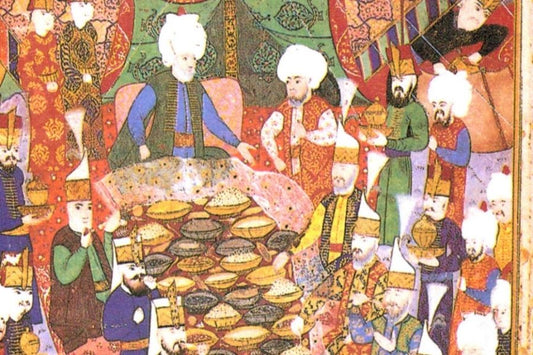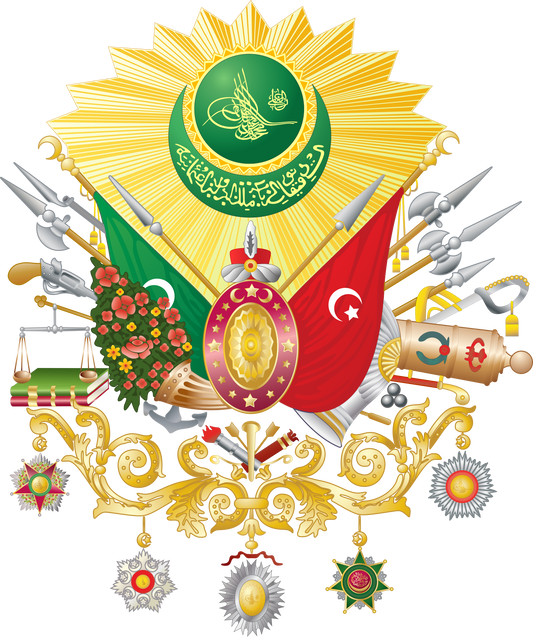In the Ottoman world, fruit was not merely a food item; it was an elegant form of presentation where aesthetics, symbolism, and hospitality converged. From daily meals to ceremonial gatherings, fruits were regarded as one of the most magnificent elements of hospitality alongside flowers. Over time, they transformed into an image that was not only consumed but also incorporated into every branch of art.
Fruit's Place at the Table
Fruit served after meals in the Ottoman era was not just a sweet ending but also a complement to conversation, music, and aesthetics. Miniatures depicting fruits such as pomegranates, apples, and pears arranged on trays, alongside tables adorned with candelabras and tulip-carnation arrangements, reflect the period's etiquette and aesthetic sensibility. At engagement, wedding, birth, and circumcision ceremonies, nahıls (ceremonial displays) prepared with flowers were also adorned with jewels, garments, and abundant fruit.
The Meaning of Paradise in Art
In Ottoman art, fruit possesses deep meanings beyond its formal beauty. In Quranic descriptions of paradise, the abundance and variety of fruits are frequently mentioned; fruits such as pomegranates, dates, and grapes are considered sacred in this context. The fact that fruit carries seeds within makes it a symbol of fertility and continuity, while in Sufi thought, the process of fruit formation is likened to human spiritual maturation.
From Nature to Pattern: Still Life and Motifs
The fruit motif most commonly appears in artworks arranged within bowls. Fruits, each of the same variety, are stacked one upon another, culminating in a single fruit at the bowl's peak. Some fruits like watermelon are depicted sliced with a knife placed in them; these depictions reflect the visual conventions of a particular period.
The 1685 Mecmua of Mahmud of Ghazni is one of the earliest examples where still life is treated as an independent subject. In this work, fruits presented alongside flowers are considered precursors to the wall paintings in the Yemiş Odası (Fruit Room) in terms of color and form.
Yemiş Odası and the Concept of Paradise Garden
The Yemiş Odası in Topkapı Palace, commissioned by Sultan Ahmed III in 1705, reveals how fruit depictions were reflected in architecture and decorative arts. Flowered vases placed in wall niches, bowls filled with fruit, and elegant baskets reflect the Tulip Era sensibility where eastern and western aesthetics intertwined. This arrangement style evokes the tile decorations in Indo-Mughal architecture.
The line "It is as if you built a palace next to Kawthar in Paradise" from the inscription on the fountain commissioned by Sultan Ahmed III during the same period clearly reveals the paradise symbolism behind such architecture and decorations.
The Form of Presentation: Ready on the Plate, Worthy of the Table
In Islamic belief, foods, especially fruits, are regarded as God's bounty. With this understanding, fruits are depicted not on their branches but in plates and bowls prepared for people. This presentation relates to the idea of bounty being offered to humanity. The fact that fruit bowls appear not only on fountains or palace walls but also on gravestones shows that the same symbolism continues as an offering in the afterlife.
On Stone, in Brushwork, and Upon Silk
In the 18th and 19th centuries, particularly in mosque and mansion decorations in Western Anatolia, depictions of fruit bowls and sliced watermelons are frequently encountered. Multi-seeded fruits such as melons, watermelons, and pomegranates are associated with abundance in this context. In mansions whose walls were decorated with paintings, brushwork, or wood carving, coffee was served after meals, and fruit was presented accompanied by saz music.
Leyla Saz, a composer and poet of the period, describes in her memoirs in detail the fruits served on large silver trays alongside candelabras on spreads laid on the floor, together with damp hand towels brought in silver containers.
Touching Time Through Embroidery
Fruit patterns in Ottoman embroidery show a parallel development with other branches of art. In examples dating to the 18th and 19th centuries, volume was added to patterns using tones of the same color alongside the dominance of pastel colors. Fruit-filled bowl and basket motifs frequently encountered on the edges of hand towels have transformed into surfaces where daily life is embroidered with elegance.
This aesthetic understanding continues to live on today in tile designs. Patterns prepared with inspiration from the Yemiş Odası located in the harem section of Topkapı Palace, bringing the flowers of the imperial garden to life in tile art, meet with traditional Turkish motifs. One of these works, "Hasbahçe Flowers – Double Anemone Flower," a tile pattern prepared by designer Serap Ereyli, can be viewed here.Retry




